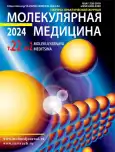Генетические предикторы риска развития осложнений в ближайшем послеоперационном периоде при боевой травме
- Авторы: Кишеня М.С.1, Соболев Д.В.1, Анчикова Е.В.2, Висягин А.В.1
-
Учреждения:
- ФГБОУ ВО «Донецкий государственный медицинский университет им. М. Горького»
- ООО «МедВитро»
- Выпуск: Том 22, № 2 (2024)
- Страницы: 48-53
- Раздел: Оригинальные исследования
- URL: https://journals.eco-vector.com/1728-2918/article/view/630273
- DOI: https://doi.org/10.29296/24999490-2024-02-08
- ID: 630273
Цитировать
Полный текст
Аннотация
Введение. Паратравматическая экзема (ПТЭ), являясь разновидностью микробной экземы, возникает после оперативных вмешательств, хронизации заживления ран, сопровождается выраженными воспалительными изменениями с гиперемией, отеком, экссудацией, болезненностью и зудом. Генетические полиморфизмы цитокинов и Toll-подобных рецепторов (TLRs) могут являться патогенетическими факторами развития ПТЭ, обусловливающими проникновение микроорганизмов и нарушение защитных свойств кожного барьера.
Цель. Изучить связь полиморфизмов rs1800629 гена TNFα, rs5743708 гена TLR2, rs3775291 гена TLR3, rs4986790 гена TLR4 с развитием паратравматической экземы у пострадавших с боевой травмой.
Материал и методы. В исследование были включены 162 пациента, из которых у 82 выявлены признаки ПТЭ (группа сравнения), у 80 человек признаки ПТЭ отсутствовали (контрольная группа). Генотипирование полиморфизмов проводили с помощью метода полимеразной цепной реакции с электрофоретической детекцией с использованием тест-систем НПФ Литех (Россия). Для статистической обработки данных использовали программу Statistica 10 (StatSoft, Inc., США).
Результаты. Установлена связь с развитием ПТЭ с вариантами генотипов и аллелей полиморфизмов: rs1800629 гена TNFα (χ2=6,9; р=0,033 и χ2=8,12; р=0,005); rs3775291 гена TLR3 (χ2=6,9; р=0,039 и χ2=5,74; р=0,018); rs4986790 гена TLR4 (χ2=8,17; р=0,018 и χ2=7,85; р=0,005). На увеличение шансов развития ПТЭ оказывали влияние генотипы GА (ОШ=1,64; 95% ДИ – 0,83–3,24) и АА (ОШ=2,94; 95% ДИ – 0,9–9,67), аллель А (ОШ=2,13; 95% ДИ – 1,26–3,6) rs1800629 гена TNFα; генотипы СТ (ОШ=1,58; 74% ДИ 0,93–3,24) и ТТ (ОШ=1,79; 95% ДИ – 0,67–4,8), аллель Т (ОШ=1,76; 95% ДИ – 1,1–2,8) rs3775291 гена TLR3; генотипы АG (ОШ=2,58; 95% ДИ – 1,24–5,37) и GG (ОШ=3,0; 95% ДИ – 0,31–29,47), аллель G (ОШ=2,44; 95% ДИ – 1,29–4,62) rs4986790 гена TLR4.
Выводы. Полиморфизмы rs1800629 гена TNFα, rs3775291 гена TLR3, rs4986790 гена TLR4 ассоциированы с развитием паратравматической экземы у пострадавших с боевой травмой.
Ключевые слова
Полный текст
Об авторах
Мария Сергеевна Кишеня
ФГБОУ ВО «Донецкий государственный медицинский университет им. М. Горького»
Автор, ответственный за переписку.
Email: maria.kishenya@gmail.com
ORCID iD: 0009-0007-7987-4091
старший научный сотрудник центральной научно-исследовательской лаборатории ФГБОУ ВО «Донецкий государственный университет им. М. Горького». Кандидат медицинских наук, доцент
Россия, 283003, ДНР, Донецк, пр. Ильича, 16Дмитрий Васильевич Соболев
ФГБОУ ВО «Донецкий государственный медицинский университет им. М. Горького»
Email: surgeon2010@yandex.ru
ORCID iD: 0009-0006-5599-6265
профессор кафедры комбустиологии и пластической хирургии факультета интернатуры и последипломного образования ФГБОУ ВО «Донецкий государственный университет им. М. Горького». Доктор медицинских наук, профессор
Россия, 283003, ДНР, Донецк, пр. Ильича, 16Екатерина Васильевна Анчикова
ООО «МедВитро»
Email: kato82@yandex.ru
ORCID iD: 0009-0002-5923-2394
врач-дерматовенеролог ООО «МедВитро»
Россия, 143401, Московская обл., Красногорский р-н, Красногорск, Подмосковный б-р, д. 11Артур Вячеславович Висягин
ФГБОУ ВО «Донецкий государственный медицинский университет им. М. Горького»
Email: turya007@mail.ru
ORCID iD: 0009-0003-2234-439X
старший лаборант кафедры комбустиологии и пластической хирургии факультета интернатуры и последипломного образования ФГБОУ ВО «Донецкий государственный университет им. М. Горького»
Россия, 283003, ДНР, Донецк, пр. Ильича, 16Список литературы
- Homey B., Steinhoff M., Ruzicka T., Leung D.Y. Cytokines and chemokines orchestrate atopic skin inflammation. J. Allergy Clin Immunol. 2006; 118 (1): 178–89. doi: 10.1016/j.jaci.2006.03.047
- Galli E., Ciucci A., Cersosimo S., Pagnini C., Avitabile S., Mancino G., Delle Fave G., Corleto V.D. Eczema and food allergy in an Italian pediatric cohort: no association with TLR-2 and TLR-4 polymorphisms. Int J. Immunopathol Pharmacol. 2010; 23 (2): 671–5.
- Li Q., Tang X., Xu J., Ren X., Wang R., Jiang S. Study on alleviation effect of stachyose on food allergy through TLR2/NF-κB signal pathway in a mouse model. Life Sci. 2021; 286: 120038. DOI: 10.1016/j. lfs.2021.120038
- Salpietro C., Rigoli L., Miraglia Del Giudice M., Cuppari C., Di Bella C., Salpietro A., Maiello N., La Rosa M., Marseglia G.L., Leonardi S., Briuglia S., Ciprandi G. TLR2 and TLR4 gene polymorphisms and atopic dermatitis in Italian children: a multicenter study. Int J. Immunopathol Pharmacol. 2011; 24 (4): 33–40. doi: 10.1177/03946320110240S408
- Poole A., Song Y., O’Sullivan M., Lee K.H., Metcalfe J., Guo J., Brown H., Mullins B., Loh R., Zhang G.B. Children with nut allergies have impaired gene expression of Toll-like receptors pathway. Pediatr Allergy Immunol. 2020; 31 (6): 671–7. doi: 10.1111/pai.13246
- Nawijn M.C., Motta A.C., Gras R., Shirinbak S., Maazi H., van Oosterhout A.J.M. TLR-2 activation induces regulatory T cells and long-term suppression of asthma manifestations in mice. PLoS ONE. 2013; 8 (2): e55307. doi: 10.1371/journal.pone.0055307
- Oh D.Y., Schumann R.R., Hamann L., Neumann K., Worm M., Heine G. Association of the toll-like receptor 2 A-16934T promoter polymorphism with severe atopic dermatitis. Allergy. 2009; 64 (11): 1608–15. doi: 10.1111/j.1398-9995.2009.02066.x
- Potaczek D.P., Nastalek M., Okumura K., Wojas-Pelc A., Undas A., Nishiyama C. An association of TLR2-16934A>T polymorphism and severity/phenotype of atopic dermatitis. J. Eur. Acad. Dermatol Venereol. 2011; 25 (6): 715–21. doi: 10.1111/j.1468-3083.2010.03812.x
- European convention for the protection of vertebrate animal used for experimental and other scientific purposes. Council of Europe. Strasbourg, 1986; 53.
Дополнительные файлы






